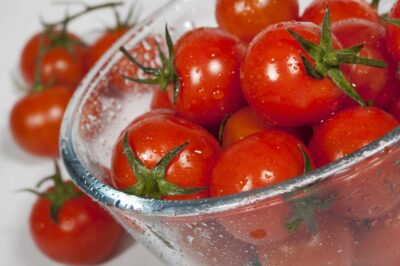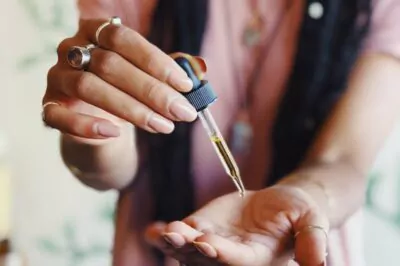When most of us hear the word “detoxing” we immediately think about diet detoxes and cleanse programs designed to get us back on track with healthy eating.
The focus is nearly always on upgrading eating habits and behaviors around food, being present and slowing down—all great things.
But “detoxing” isn’t just for our bodies! In order to reduce the levels of toxic agents inside our body we need to focus on reducing exposures first. And the best place to start reducing exposure is in the kitchen.
Our homes are filled with products that expose us to potentially harmful chemicals every single day that are linked to a wide range of health issues—everything from weight gain and diabetes, to infertility, thyroid disorders and cancers.
Diet based detoxes and cleanse programs are great at helping us reset healthy eating habits but they rarely do anything to address the toxic things in our homes that might be making us sick. While the idea of addressing toxic agents in our lives might feel overwhelming, it definitely doesn’t have to be! A little perspective and reframing can go a long way.
It’s Not About Perfection, It’s About Doing Our Best
When people first start learning about environmental chemicals and their health effects, there’s often this strong desire to live a totally, 100% toxic free life. While I wish this was possible, it’s simply not. The reality is that we cannot change everything or avoid toxic agents completely. So rather than feel overwhelmed, I like to focus on the areas of our lives that we can easily change.
“Change the things we can control, so we worry less about the ones we can’t.” This sentiment encapsulates the entire ethos of my approach to environmental toxins, and it allows me to address the issue head on without ever feeling overwhelmed.
How to Keep Pests Out of Your Home, Naturally
Urban Gardening: Regrow Your Kitchen Veggies
How to Avoid and Detox From Heavy Metals
The goal is never 100% purity. Instead, the goal is imperfect action towards a healthier, less toxic life. We do the best we can.
Detoxing Your Kitchen
Even though we are exposed to potentially harmful chemicals like cancer causing VOC’s and endocrine disruptors in every room in our house, the kitchen is the best place to start reducing our exposures.
The kitchen is a room that you’re already flexing your healthy muscles in—upgrading your foods, cooking more, and maybe even meal planning, all in the name of achieving optimal health. So it makes perfect sense to start tackling the toxins that are hiding out and potentially sabotaging your efforts at getting and staying healthy!
Let’s walk through the top 3 toxic items found in the kitchen and how to swap them for safer versions:
Aim for Organic
Worldwide, about 5.6 billion pounds of pesticides are used each year, 1 billion of which is used here in the US and those pesticides and fungicide residues on foods end up making their way into our bodies.
Outside of people who apply pesticides professionally, our primary exposure to these chemicals is through our food and water. In fact, the Centers for Disease Control and Prevention states that “people are exposed to organophosphorus insecticides by eating foods treated with these chemicals”.
Commonly used pesticides, like chlorpyrifos have been measured in more than 90% of people tested by the CDC. Chronic, low-dose exposure to pesticides is linked to a wide range of health effects; reproductive issues, low IQ, neurodevelopmental and behavioral issues in children, ADHD, infertility, chronic fatigue, fibromyalgia, Alzheimer’s, Parkinson’s, gut dysbiosis, and cancers.
Switching to a mostly organic diet can dramatically reduce the levels of pesticides in our bodies. In fact, recent studies have demonstrated that both children and adults can experience a dramatic reduction in pesticide levels in their bodies—a drop of 80-90% in just 3-5 days!
What’s great is that this research was conducted on the basis of people eating mostly organic, not entirely organic, which can be hard. This just goes to show that any effort we make it worth making. Even the CDC has stated that “subjects ingesting “organically-grown” foods were shown to have lower levels of urinary dialkyl phosphates than subjects eating a conventional diet.”
To help make the most of your grocery budget, check out the Environmental Working Group’s Dirty Dozen, Clean Fifteen list of the 12 fruits and veggies with the highest pesticide residues (buy organic versions of these) and the 15 with the least (you can buy conventional of these)
Purge The Plastic
Open all the cabinets & drawers in your kitchen and spend a moment taking a visual inventory of all the plastic. Cups, plates, food storage containers, spatulas, mixing bowls, pasta strainers, cooking utensils, measuring cups, travel bottles.
Plastic in our kitchen isn’t always bad, but plastics that have direct food contact isn’t ideal and is a very common source of exposure to some of the most ubiquitous chemicals in our environment: endocrine disruptors.
The conversation around harmful chemicals in plastics is most commonly had around BPA, a chemical used in clear, hard polycarbonate plastic. Bisphenol-A is a synthetic estrogen that can block or mimic the role of natural estrogen in the body, causing or contributing to a long list of health issues, in particular estrogen dominant ones like breast cancer as well as developmental and behavioral issues.
BPA-Free plastics have taken over the shelves these days as people rushed to toss out regular polycarbonate bottles due to concerns over these leaching estrogens, but sadly, they’re not any better!
Plastics manufacturers have simply swapped BPA for other nearly identical chemicals in the same family; BPS and BPF, which newer research is showing to be just as bad if not worse.
But it’s not just polycarbonate plastics that are the issue. A number of studies have found that all types of plastics leach some type of estrogenic compounds.
It’s for this reason that purging the plastics from your kitchen is so important! The easiest replacement is to simply use glass food storage containers. These are readily found in big box stores, and Pyrex even has a line of containers that have glass and silicone lids, which are my favorite.
For a super inexpensive fix, I use Ball Mason Jars for just about everything, and they double as drinking glasses.
For things like cooking utensils, mixing bowls and strainers, aim for stainless steel. Not only will they not leach estrogenic compounds, but they should last forever. Visit the website www.myplasticfreelife.com for more plastic free alternatives.
Toss The Canned Foods
Although we often think of canned foods in terms of being less nutritious than fresh, some canned staples are still found in nearly every kitchen pantry; canned tomatoes and canned beans.
Canned foods, with a few exceptions, are also a source of exposure to those same bisphenol chemicals found in plastics. The interior surface of cans are lined with a type of BPA which can, and does, migrate out into the foods packed in them.
This is especially true for canned tomatoes. Tomatoes are a highly acidic food, and that acid can increase the amount of chemicals that leech from the can lining into the food. When tested, tomatoes consistently have some of the highest levels of BPA in them.
Thankfully a small number of companies do package their tomatoes in jars – look for these when stocking your pantry!
There are of course other sources of exposure to toxic elements in your kitchen and elsewhere in your home, but I’m a firm believer in detoxing our lives in small, incremental steps.
If you’re ready to dive deeper into detoxing your world, check out my Tools for Teaching Toxicity course. This self directed 4-week program will go much deeper into the issues and action steps around toxins in your kitchen, as well as looking at household cleaners, personal care products, and makeup.
Use promocode ‘annmarie’ to save 25% on course tuition!
References:
Alavanja, Michael CR. “Introduction: Pesticides Use and Exposure, Extensive Worldwide.” Reviews on environmental health 24.4 (2009): 303-310. Web
Behan, Peter O. “Chronic fatigue syndrome as a delayed reaction to chronic low-dose organophosphate exposure.” Journal of Nutritional & Environmental Medicine 6.4 (1996): 341-350. Web.
Bell, Iris R., Carol M. Baldwin, and Gary E. Schwartz. “Illness from low levels of environmental chemicals: relevance to chronic fatigue syndrome and fibromyalgia.” The American journal of medicine 105.3 (1998): 74S-82S.
Biomonitoring Summary: Organophosphorus Insecticides: Dialkyl Phosphate Metabolites.” Centers for Disease Control and Prevention. Web.
Bouchard, Maryse F., et al. “Prenatal exposure to organophosphate pesticides and IQ in 7-year-old children.” Environmental health perspectives 119.8 (2011): 1189.
Bouchard, Maryse F., et al. “Attention-deficit/hyperactivity disorder and urinary metabolites of organophosphate pesticides.” Pediatrics 125.6 (2010): e1270-e1277. Web.
“Fourth National Report on Human Exposure to Environmental Chemicals.” Centers for Disease Control and Prevention, 2009. Web.
Gatto, Nicole M., et al. “Well-water consumption and Parkinson's disease in rural California.” Environmental health perspectives (2009): 1912-1918. Web.
Hayden, Kathleen M., et al. “Occupational exposure to pesticides increases the risk of incident AD The Cache County Study.” Neurology 74.19 (2010): 1524-1530. Web.
Joly, Claire, et al. “Impact of chronic exposure to low doses of chlorpyrifos on the intestinal microbiota in the Simulator of the Human Intestinal Microbial Ecosystem (SHIME®) and in the rat.”Environmental Science and Pollution Research20.5 (2013): 2726-2734.
Jurewicz, Joanna, and Wojciech Hanke. “Prenatal and childhood exposure to pesticides and neurobehavioral development: review of epidemiological studies.” International journal of occupational medicine and environmental health 21.2 (2008): 121-132. Web.
Recio, Rogelio, et al. “Pesticide exposure alters follicle-stimulating hormone levels in Mexican agricultural workers.” Environmental health perspectives (2005): 1160-1163. Web







